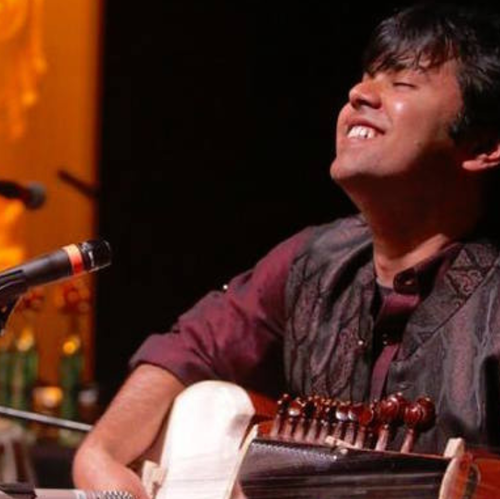Sarod Diaries:Sounds of the Subcontinent
Details
Souryadeep Bhattacharyya full profile / Sarod and Tabla Duo / 2 musicians
Other players: To be decided based on dates
Full program notes
This program is a journey into the world of Hindustani classical music, the North Indian classical tradition, performed on the sarod with live tabla accompaniment. The sarod’s deep, resonant tone captures both meditative stillness and vibrant rhythmic energy, carrying the heritage of the Indian subcontinent while speaking directly to the present moment.
Raga Performance (First half: about 30 minutes)
The heart of the evening will be a performance of one or more ragas, the melodic framework of Indian classical music. A raga is more than a scale; it is a living mood that evokes a time of day, a season, and an emotion. The music begins with a slow, free-flowing alaap—an unaccompanied exploration of the raga’s phrases and mood—before gradually building pulse and rhythm. With the entrance of the tabla, the performance blossoms into intricate improvisations, weaving melody and rhythm in a dynamic dialogue.
Why this matters: Each raga is a new journey. No two performances are ever the same—every note is shaped by tradition, the moment, and the energy of the audience.
Lighter Classical & Semi-Classical Pieces (Second Half: about 15 minutes)
To complement the raga, I often include pieces that connect tradition with accessibility:
Dhuns (folk-inspired melodies): Bright, playful, and rooted in the musical traditions of villages and daily life.
Rabindrasangeet (songs of Rabindranath Tagore): Soulful melodies from Bengal set to timeless poetry, bridging classical and lyrical traditions.
Ghazals or folk tunes: Romantic and expressive, these pieces highlight the adaptability of the sarod beyond purely classical structures.
Why this matters: These selections create an open, inviting space for audiences. They show how Indian classical music embraces not only depth and discipline, but also joy, poetry, and community.
My Approach
I choose these pieces because they reflect the full spectrum of what the sarod can express—from meditative introspection to playful celebration. The mix of traditional raga performance with semi-classical and folk elements allows audiences, whether new or seasoned, to experience both the depth of Hindustani classical music and the living cultural tapestry of the subcontinent.
Each program is shaped in the moment. I often welcome audience requests, adapting with dhuns, folk melodies, or Rabindrasangeet, so the evening feels personal and shared. For me, music is a dialogue, and Groupmuse is the perfect space for that exchange.
Historical context
Tonight’s music comes from the rich tradition of Hindustani classical music, which has flourished in the Indian subcontinent for centuries. Rooted in the ancient systems of raga (melody) and tala (rhythm), this tradition developed in temples, courts, and gatherings, where music was not just entertainment but a spiritual and communal experience. The sarod itself traces its lineage back to instruments like the rabab, evolving into its present form in the 19th century as one of the principal voices of North Indian classical music.
I began my journey in the Shahjahanpur Gharana with Late Jayanta Roychowdhury, and for over 25 years I have trained in the Maihar Gharana under Pt. Alok Lahiri—a school shaped by Ustad Allauddin Khan, who brought together diverse influences to form a modern, expansive approach to Indian music. This commitment to musical lineage connects every performance to a larger story: one of teachers and students passing on knowledge, of traditions adapting to new times, and of music continuing to bring communities together across generations.
Videos from this player
Audio from this player

 Continue with Facebook
Continue with Facebook
 Continue with Google
Continue with Google
 Continue with Apple
Continue with Apple





